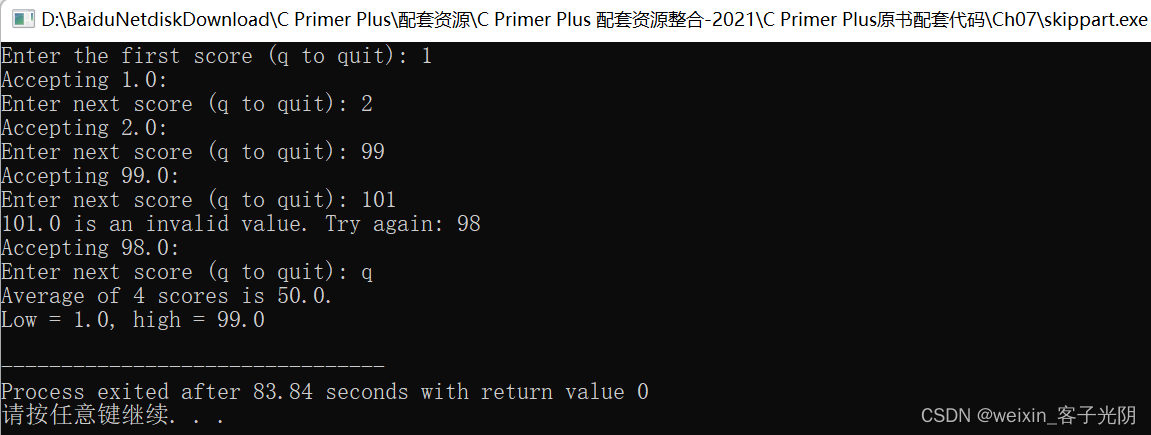7.6 循环辅助:continue和break
continue和break语句可以根据循环体的测试结果来忽略一部分循环内容,甚至结束循环。
7.6.1 continue语句
3种循环都可以使用continue语句。执行到该语句时,会跳过本次迭代的剩余部分,并开始下一轮迭代。如果continue语句在嵌套循环内,则只会影响包含该语句的内层循环。
/* skippart.c -- uses continue to skip part of loop */
#include <stdio.h>
int main(void)
{
const float MIN = 0.0f;
const float MAX = 100.0f;
float score;
float total = 0.0f;
int n = 0;
float min = MAX;
float max = MIN;
printf("Enter the first score (q to quit): ");
while (scanf("%f", &score) == 1)
{
if (score < MIN || score > MAX)
{
printf("%0.1f is an invalid value. Try again: ",
score);
continue; // jumps to while loop test condition
}
printf("Accepting %0.1f:\n", score);
min = (score < min)? score: min;
max = (score > max)? score: max;
total += score;
n++;
printf("Enter next score (q to quit): ");
}
if (n > 0)
{
printf("Average of %d scores is %0.1f.\n", n, total / n);
printf("Low = %0.1f, high = %0.1f\n", min, max);
}
else
printf("No valid scores were entered.\n");
return 0;
}
/* 输出:

*/
注意,有两种方法可以避免使用continue,一是省略continue,把剩余部分放在一个else块中:
if( score < 0 || score > 100 ){
/*printf()语句*/
} else{
/*语句*/
}
另一种方式是,用以下格式来代替:
if( score >= 0 && score <= 100 ){
/*语句*/
}
这种情况下,使用continue的好处是减少主语句组中的一级缩进。当语句很长或嵌套较多时,紧凑简洁的格式提高了代码的可读性。
continue还可用作占位符。下面的循环读取并丢弃输入的数据,直至读到行末尾:
while( getchar() != '\n' )
;
当程序已经读取一行中的某些内容,要跳至下一行开始处时,这种方法很方便。问题是,一般很难注意到一个单独的分号。如果使用continue,可读性会更高:
while( getchar() != '\n' )
continue;
如果用了continue没有简化代码反而让代码更复杂,就不要使用continue。例如:
while( (ch = getchar()) != '\n' ){
if( ch == '\t' ){
continue;
}
putchar( ch );
}
以上代码这样表示更简洁:
while( (ch = getchar()) != '\n' ){
if( ch != '\t' ){
putchar( ch );
}
}
通常,在这种情况下,把if的测试条件的关系反过来便可避免使用continue。
对于while和do while循环,continue语句后的下一个行为是对循环的测试表达式求值。
count = 0;
while( count < 10 ){
ch = getchar();
if( ch == '\n' ){
continue;
}
putchar( ch );
count++;
}
对于for循环,执行continue后的下一个行为是对更新表达式求值,然后是对循环测试表达式求值。
for( count = 0; count < 10; count++ ){
ch = getchar();
if( ch == '\n' ){
continue;
}
putchar( ch );
}
while循环的例子中,除了换行符,其余字符都显示;而本例中,换行符也计算在内,所以读取的10个字符中包含换行符。
7.6.2 break语句
程序执行到循环中的break语句时,会终止包含它的循环,并继续执行下一阶段。如果break语句位于嵌套循环内,它只会影响它的当前循环。
break还可用于因其他原因退出循环的情况。
循环计算矩形的面积。
/* break.c -- uses break to exit a loop */
#include <stdio.h>
int main(void)
{
float length, width;
printf("Enter the length of the rectangle:\n");
while (scanf("%f", &length) == 1)
{
printf("Length = %0.2f:\n", length);
printf("Enter its width:\n");
if (scanf("%f", &width) != 1)
break;
printf("Width = %0.2f:\n", width);
printf("Area = %0.2f:\n", length * width);
printf("Enter the length of the rectangle:\n");
}
printf("Done.\n");
return 0;
}
/* 输出:

*/
可以这样控制循环:
while( scanf( "%f %f", &length, &width ) == 2 )
但是,用break可以方便显示用户输入的值。
和continue一样,如果用了break代码反而更复杂,就不要使用break。例如:
while( (ch = getchar()) != '\n' ){
if( ch == '\t' ){
break;
}
putchar( ch );
}
如果把两个测试条件放在一起,逻辑就更清晰了:
while( (ch = getchar()) != '\n' && ch != '\t' )
putchar( ch );
break语句对于稍后讨论的switch语句而言至关重要。
在for循环中的break和continue的情况不同,执行完break语句后会直接执行循环后面的第1条语句,连更新部分也跳过,嵌套循环内层的break只会让程序员跳出包含它的当前循环。